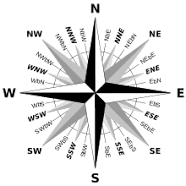From the North Pole, all directions are south. Its latitude is 90 degrees north, and all lines of longitude meet there (as well as at the South Pole, on the opposite end of Earth). Polaris, the current North Star, sits almost motionless in the sky above the pole, making it an excellent fixed point to use in celestial navigation in the Northern Hemisphere.
Because Earth rotates on a tilted axis as it revolves around the sun, sunlight is experienced in extremes at the poles. In fact, the North Pole experiences only one sunrise (at the March equinox) and one sunset (at the September equinox) every year. From the North Pole, the sun is always above the horizon in the summer and below the horizon in the winter. This means the region experiences up to 24 hours of sunlight in the summer and 24 hours of darkness in the winter.
Birds are frequent visitors to the North Pole. The Arctic tern (Sterna paradisaea), which has the longest annual migration of any species on the planet, spends its spring and summer in the Arctic, though rarely as far north as the North Pole. It then flies 30,000 kilometers (18,641 miles) south, to the Antarctic Circle. The Arctic tern makes an Arctic-Antarctic round-trip migration every year.
Like the Arctic tern, all other birds spotted near the North Pole are migratory. They include the small snow bunting (Plectrophenax nivalis) and gull-like fulmars and kittiwakes.Antarctica is the only continent with no permanent human habitation. There are, however, permanent human settlements, where scientists and support staff live for part of the year on a rotating basis.
The Antarctic Ice Sheet dominates the region. It is the largest single piece of ice on Earth. This ice sheet even extends beyond the continent when snow and ice are at their most extreme.
The ice surface dramatically grows in size from about three million square kilometers (1.2 million square miles) at the end of summer to about 19 million square kilometers (7.3 million square miles) by winter. Ice sheet growth mainly occurs at the coastal ice shelves, primarily the Ross Ice Shelf and the Ronne Ice Shelf. Ice shelves are floating sheets of ice that are connected to the continent. Glacial ice moves from the continent’s interior to these lower-elevation ice shelves at rates of 10 to 1,000 meters (33 to 32,808 feet) per year.
Antarctica has a number of mountain summits, including the Transantarctic Mountains, which divide the continent into eastern and western regions. A few of these summits reach altitudes of more than 4,500 meters (14,764 feet). The elevation of the Antarctic Ice Sheet itself is about 2,000 meters (6,562 feet) and reaches 4,000 meters (13,123 feet) above sea level near the center of the continent.

Funeral BluesStop all the clocks, cut off the telephone, Prevent the dog from barking with a juicy bone, Silence the pianos and with muffled drum Bring out the coffin, let the mourners come. Let aeroplanes circle moaning overhead Scribbling on the sky the message He Is Dead, Put crepe bows round the white necks of the public doves, Let the traffic policemen wear black cotton gloves. He was my North, my South, my East and West, My working week and my Sunday rest, My noon, my midnight, my talk, my song; I thought that love would last for ever: I was wrong. The stars are not wanted now: put out every one; Pack up the moon and dismantle the sun; Pour away the ocean and sweep up the wood; For nothing now can ever come to any good. W H Auden
Thank you for reading, AdeleEmail ThisBlogThis!Share to TwitterShare to Facebook
